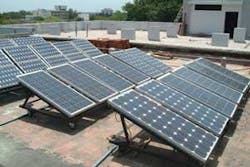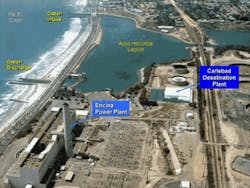One of the most advanced seawater desalination projects under development today is the 50 mgd facility in Carlsbad, CA. This project is co-located with the Encina coastal power generation station which currently uses seawater from the Pacific Ocean for once-through cooling. The Carlsbad seawater desalination project is developed as a public-private partnership between the project proponent, Poseidon Resources, and eight local utilities and municipalities.
The Carlsbad project received a “green light” from all regulatory agencies in California in August 2008 and is planned to begin construction in the spring of 2009. When completed in 2011, this project will supply 6% to 8% of the drinking water in San Diego County and will be the largest seawater desalination plant in the USA.
In 2006, California legislation introduced the AB 32 Global Warming Solutions Act which aims to reduce the greenhouse gas (GHG) emissions of the state to 1990 levels by year 2020. In response to this initiative, the project team has committed to mitigate the carbon footprint associated with the desalination plant. When constructed, this will be the first desalination project in the US which will have a zero carbon footprint.
Carbon Footprint
The total plant carbon footprint of a desalination facility is dependent on two key factors: (1) how much electricity is used by the desalination plant; and (2) what sources (fossil fuels, wind, sunlight, etc.) are used to generate the electricity supplied to the plant. The total carbon footprint for this project is estimated at 61,000 metric tons CO2/yr and is based on desalination plant power use of 13.5 KWh/1,000 gallons of produced drinking water and on a greenhouse gas emission factor of 248.4 kg of CO2 per MWh of electricity used for the project.
Water Imports
Currently, San Diego County imports 90% of its water from the distant Sacramento Bay Delta and Colorado River via the State Water Project. The amount of electricity needed to deliver and treat this water is 10.4 KWh/1,000 gallons. Since the desalination project will eliminate the need for import of 50 mgd of water this will save 189,800 MWh/yr, or 47,240 metric tons CO2/yr of GHG emissions from the energy used to pump this water to the county. Thus the Carlsbad desalination plant’s net carbon footprint is estimated to be reduced from 61,000 to 13,760 metric tons CO2/yr.
null
Reduction Measures
Project developers plan to eliminate the plant’s net carbon footprint altogether by: energy efficient design and operations; green building design; use of carbon dioxide for water production; on-site solar power generation; carbon dioxide sequestration by creation of coastal wetlands and reforestation; funding renewable power generation projects; and acquisition of renewable energy credits.
Energy Efficiency
The plant will use a state-of-the-art energy recovery system to capture and reuse energy from the seawater concentrate generated in the salt separation process.
After membrane separation, most of the energy applied for desalination is retained in the concentrated stream (“brine”) that also contains the salts removed from the seawater. This energy bearing stream is applied to the back side of pistons of cylindrical isobaric chambers, also known as “pressure exchangers”. These pistons pump approximately 45-50% of the seawater fed into the reverse osmosis membranes for desalination.
Warm Seawater Source
An average of 5% of additional energy savings and respective carbon footprint reduction (12,308 MWh/yr and 3,057 tons/CO2 per year) are projected to be achieved by using warm cooling water from the Encina Power Generation Station as source seawater rather than collecting cold ambient seawater via a separate ocean intake. The osmotic pressure which has to be overcome during the salt separation process decreases with the increase of seawater temperature. Since the power plant discharge has approximately 5°C higher temperature than the ambient seawater, the innovative collocation technology used for the Carlsbad desalination project will yield both energy and GHG reduction savings.
Green Building Design
The desalination plant will be located on a site currently occupied by a dilapidated fuel oil storage tank. Reclaiming the land will reduce project imprint on the environment as compared to using an undisturbed site for the desalination plant.
A key “green” feature of the plant design is its compactness by sharing common walls, roofs and equipment which would allow significant reduction of its physical footprint. The total area occupied by the desalination plant facilities would be less than 5 acres. When built, this would be the smallest footprint desalination plant in the world per unit production capacity (5 acres per 50 mgd).
Building design will follow the principles of the Leadership in Energy and Environmental Design (LEED) program that aims to reduce the overall impact on the environment of building construction and functions. Minimizing energy use for lighting, air conditioning and ventilation will be achieved by, for example, translucent panels to maximize daylight use and views to the outside, automatic light switching, monitored ventilation in the individual working areas and water conserving fixtures for service facilities and landscape irrigation. The energy savings associated with the implementation of the green building design are in a range of 300 MWh/yr to 500 MWh/yr. The carbon footprint reduction associated with this design is between 75 and 124 tons of CO2 per year.
Solar Power
One enhancement of the green building design is the installation of rooftop photovoltaic (PV) system for solar power generation. The main desalination plant building would have a roof surface of approximately 50,000 square feet, which would be adequate to house a solar panel system that could generate approximately 777 MWh/yr of electricity and reduce the net carbon footprint of the desalination plant by 193 metric tons of CO2 per year.
Carbon Dioxide
Approximately 2,100 tons of CO2 per year are planned to be used at the desalination plant for final conditioning of the fresh water for corrosion protection. The drinking water ion balance (pH) will be maintained in a range (pH of 8.3 to 8.5) which allows the CO2 to remain sequestered with the drinking water. The desalination plant is planned to use only carbon dioxide collected from industrial operations which generate this gas as a waste stream (i.e., breweries, ethanol plants, etc.), which otherwise will be released in the air.
Re-vegetation of Wildfire Zones
Almost every year parts of San Diego County experience large wildfires. For example, in 2007 San Diego wildfires burned over 35,000 acres, including forests, tree farms and urban forestry. In response to an ongoing wildfire zone re-vegetation program spearheaded by the California Coastal Commission, Poseidon Resources has committed to invest US$1.0 million in reforestation activities. Total annual carbon footprint reduction associated with the tree sequestration project is estimated at 166 metric tons of CO2 per year.
Coastal Wetlands
As a part of the Carlsbad seawater desalination project, Poseidon Resources is planning to develop 37 acres of new coastal wetlands in San Diego County. These wetlands will be designed to create habitat for marine species similar to these found in the Agua Hedionda Lagoon (see Figure 1), from which source seawater is collected for the power plant and for desalination plant operations.
In addition to the benefit of marine habitat restoration and enhancement, coastal wetlands also act as a “sink” of carbon dioxide. Tidal wetlands are very productive habitats that remove significant amounts of carbon from the atmosphere, a large portion of which is stored in the wetland soils. While freshwater wetlands also sequester CO2, they are often a measurable source of methane emissions. For comparison, coastal wetlands and salt marshes release negligible amounts of greenhouse gases and therefore, their carbon sequestration capacity is not measurably reduced by methane production. The offset of the desalination plant carbon footprint by the wetland project is estimated at 304 tons of CO2/year.
Other Carbon Offset Projects and Renewable Credits
For the remainder of the Project’s GHG emissions, Poseidon will purchase a combination of carbon offset projects and Renewable Energy Credits (RECs). Contracts for offset projects provide more price stability and are typically established for longer terms (10-20 years) then RECs (1-3 years). Offsets or RECs will be used as the swing mitigation option to “true-up” annual changes to the Project’s net carbon footprint. WW
About the Author:
Nikolay Voutchkov, PE, DEE, has over 25 years of experience in the field of seawater desalination and water and wastewater treatment. He is a Chief Technology Officer of Poseidon Resources - a US company specialized in developing large water infrastructure projects. He is one of the principal authors of the latest edition of the AWWA Manual on Reverse Osmosis and Nanofiltration, and the new WHO Desalination Guidelines. Voutchkov may be contacted at [email protected].





